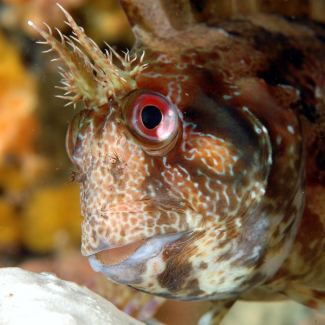
Blood of glaciers: how an alga adapts to living in snow
In the spring, Alpine glaciers sometimes don a sheer red or orangish veil. Known as ‘red snow’ or ‘blood snow’, this phenomenon is caused by the blooming of Sanguina nivaloides, a microscopic alga. Scientists from the CNRS, the French Alternative Energies and Atomic Energy Commission (CEA), Météo-France, INRAE, and Université Grenoble Alpes1 turned their attention to this organism, which forms the pillar of a snowy ecosystem still poorly understood. Through their investigation2 , whose findings have just been published in Nature Communications, they determined that S. nivaloides does not live in ice crystals but rather grows in the water circulating within the snow, around those crystals. The biologists then studied the cellular architecture of the algae using 3D electron microscopy, discovering adaptations that permit its life in the snow. For example, they noted that the cellular membrane of S. nivaloides is covered with small wrinkles that increase its external surface area. This enhances uptake of ions necessary for growth in its extremely nutrient-poor surroundings.
The inside of the algal cell also had surprises in store for the researchers. An S. nivaloides cell has only one chloroplast, whose thylakoids—the disk-shaped membranes where photosynthesis takes place—are not all oriented in the same direction as they are in most photosynthesising organisms. Instead, they fan out to receive light from every direction. Such an adaptation is eminently suited to life in the snow, where light is reflected and diffused as in a hall of mirrors. Mitochondria, the cell’s power plants, surround the chloroplast to receive and process the starch it synthesizes. Finally, the team focused on the red carotenoid pigments of S. nivaloides. These apparently do not shield the cell nucleus from UV radiation, as had been thought, but protect the algae from the harmful effects of free radicals within an environment bathed in intense light.
When the snow around it has melted, S. nivaloides is deposited in the soil, where it metamorphoses to adapt to this completely different environment. The scientists would now like to understand this transformation process, which has never been studied before. Here time is of the essence because the entire ecosystem built around S. nivaloides is threatened by climate change and decreased mountain snowfall.

© Grégory Si Larbi (LPCV)
- 1The team’s members hail from the Cell & Plant Physiology Laboratory (LPCV) (CNRS/CEA/UGA/INRAE),
the French National Centre for Meteorological Research (CNRM) (CNRS/Météo-France), the Modelling and Exploration of Materials (MEM) laboratory (CEA/UGA), the Institut de Biologie Structurale (CNRS/CEA/UGA), and the Lautaret Garden support and research unit (CNRS/UGA). - 2This research was supported by the French National Research Agency (ANR) through the AlpAlga programme (https://www.cnrs.fr/en/press/alpalga-search-mountain-snow-microalgae) and was the first whose findings were published with help from the Kilian Jornet Foundation.
Adaptative traits of cysts of the snow alga Sanguina nivaloides unveiled by 3D subcellular imaging. E. Maréchal, et al. Nature Communications, 18 november 2023.
DOI: https://doi.org/10.1038/s41467-023-43030-7


